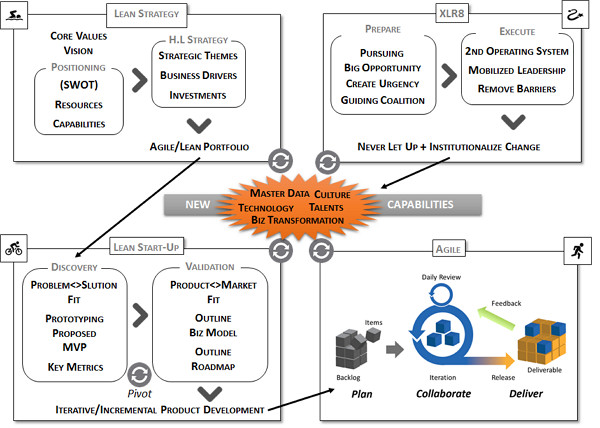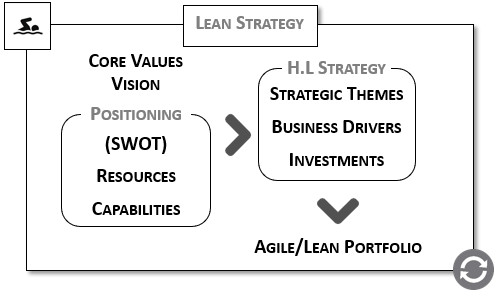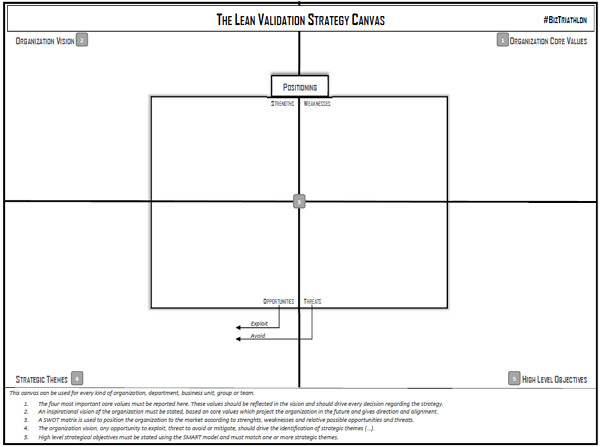Last Saturday I participated to the Agile Business Day conference in Venice. It was a day very well spent because of the speakers and, obviously, of Venice too!
Actually, I was one of the speakers :o) and presented a talk called “Business Triathlon. How to change, innovate and produce value quickly, in environments subject to constant turbulence.“
The model I presented, is mainly focused on how to remain competitive (Change the Biz) continuing to deliver value and results (Run the Biz) with constant pace. It incorporates four major approaches: Lean Strategy, Lean Start-up, Agile and Change Management.
This post is mainly focused on the Lean Strategy topic and presents the Lean Strategy Validation Canvas.
I use that tool with customers that wants to validate the vision of the organization against its real position in the market and finally come out with strategic themes and objectives, which can thought as pillars of the strategy.
But first let’s take a closer look at the whole model.

I used the metaphor of triathlon for many reasons you can find in my presentation here, but the core concept is that we can somehow link the three domains of the model, according to main characteristics of the triathlon disciplines:
- Swimming: Strategic, Explorative, Resource Balancing
- Cycling: Emergent Strategy/Tactic, Technical, Tear-And-Go
- Running: Pragmatic, Consolidation, Constant Pace
There’s actually another important “discipline” in Triathlon that someone calls the 4th discipline, which is the transition from one fraction to the other. It can actually thought as a Check Point, where your body adapts and you also change your equipment to face the next fraction. A kind of transformation happens.
The #BizTriathlon model maps this with Change Management approach and the XLR8 model from J. Kotter is the best approach which could fit.
This post regards the formulation of a Strategy (swimming), using a lean approach.

Usually senior management agrees upon a high level strategy for the organization, based on company’s vision, values, objective and scope.
Wishful thinking and complacency must be avoided, relentlessly. This is why the management should examine in detail, the organization strengths and possible opportunities, weaknesses and related threats, resources available and internal capabilities.
Having this clear picture in front of you, makes you more confident in deciding anything, moreover the company’s strategy.

When a strategy is well declined and agreed, it’s time to analyze and define the initiatives able to realize that. The canvas helps a company who wants to go into the above described process, to finally create its own strategy.
Let’s take a closer look into the canvas.
First of all, it’s worth specifying that this tool can be used for every kind of organization, department, business unit, group, etc.
We have five quadrants, each one marked with numbers which indicate the compilation sequence:
- ORGANIZATION CORE VALUES
- ORGANIZATION VISION
- POSITIONING / SWOT MATRIX
- STRATEGIC THEMES
- HIGH LEVEL OBJECTIVES
ORGANIZATION CORE VALUES
The four most important core values must be reported here. These values, should guide the realization of and be reflected in, the vision and hopefully they drive every decision regarding the formulation of the strategy.
ORGANIZATION VISION
An inspirational vision of the organization must be formulated, based on core values, which will project the organization in the future, giving direction and alignment.
POSITIONING / SWOT MATRIX
A SWOT matrix is used to position the organization to the market according to internal strengths and weaknesses and opportunities and threats.
STRATEGIC THEMES
The organization vision, opportunities to exploit, threats to avoid and/or mitigate, all together drive the identification of strategic themes, which are itemized business objectives, providing context for decision making.
HIGH LEVEL OBJECTIVES
Finally, high level strategical objectives must be stated using the SMART model and must match one or more strategic themes.
I use this tool to lead specific workshops to formulate the organizational strategy. Once the management fully agrees on results, it’s time to start “feeding” the Lean Portfolio.
But, actually, this is the next step in the #BizTriathlon model, which I am going to cover in one of the next post.
Well, remember, you’ve just started your triathlon race and you are swimming with many others fierce competitors….
Enjoy :o)


